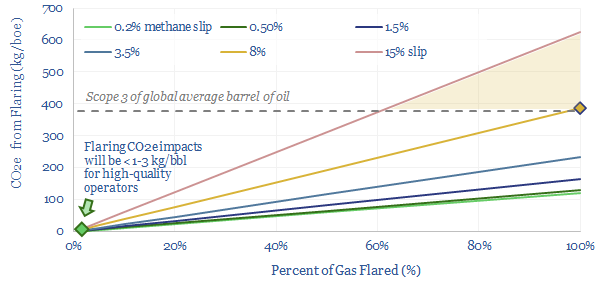Controversies over oil industry flaring are re-accelerating, especially due to the methane slip from flares, now feared as high as 8% globally. The skew entails that more CO2e could be emitted in producing low quality barrels (Scope 1) than in consuming high quality barrels (Scope 3). Insane environmental impacts are entirely preventable. This 10-page note explores how, across producers, energy services and new technologies.
145 bcm of gas is flared globally, as 1.5 mcf/bbl bubbles out of the global average oil barrel, of which 0.2 mcf/bbl gets flared. Country-by-country dynamics are summarized on page 2.
Methane slip is a growing controversy. Methane causes 25-120x more warming than CO2. New technologies to mitigate methane leaks are evolving rapidly. But one of the biggest sources of leaks is incomplete combustion in flares, also known as methane slip. Numbers and controversies are presented on pages 3-4.
Insane implications. After exploring these numbers, we strongly believe there are barrels of oil in the market where the Scope 1 CO2 from low-quality flaring is higher than the Scope 3 CO2 from combustion. Or in other words, there can be less CO2 emitted from burning high quality barrels than from producing low quality barrels. The maths are on page 5.
The biggest challenge is to mitigate flaring outside of the US, Canada and Europe, which themselves account for 8% of global flaring, and <5% of the global CO2e from flaring. Clearly and categorically, the best way to do this is to develop gas value chains. Case studies prove this point and are outlined on page 6.
Preventing flaring requires investment, estimated at $70bn upstream, and $50bn in LNG liquefaction facilities, and pulling on an extremely broad array of sub-industries, from compressors to pipelines to new technologies. We have screened examples of companies and technologies that will help to reduce flaring on page 7.
Case studies of flaring reduction and leading companies involved? Approximately half of the challenge is in gathering and monetizing gas that is more than 20km from any existing infrastructure (page 8) and the other half of the challenge is in capturing small and hard-to-capture gas streams (page 9).
There are hundreds of reasons why oil industry flaring occurs; hundreds of solutions to improve the quantity and quality of associated gas handling; but likely you do not want to read hundreds of pages cataloguing all of these examples. Our solution is to end by summarizing some of the companies that stood out most from our work, and which may be interesting for decision-makers to explore further (page 10).

